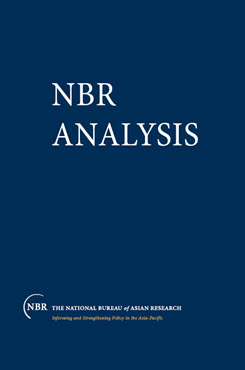NBR Analysis vol. 13, no. 5
The China-India-U.S. Triangle
Strategic Relations in the Post-Cold War Era
A new strategic triangle among the United States, China, and India emerged from the flux in international relations created by the end of the Cold War. This article examines the dynamics of the rapidly developing Sino-Indian-U.S. triangle and traces the process by which all three actors have learned the rules of the new strategic relations.
A distinctive pattern of triangular interaction has emerged in relations among China, India, and the United States during the post–Cold War period. This pattern became increasingly distinct as the 1990s progressed, and by 2001 was quite strong. India and the United States had to learn the rules of the new game, while China seems to have understood those rules all along. This article traces the origin, evolution, and operation of the new pattern of triangular relations between India, China, and the United States. While this paper does not demonstrate that issues involving China were the sole or even the most important factors driving the new India–U.S. relation that emerged in the 2000s, it does suggest that China was one significant factor in the emergence of the new Indo–U.S. relationship.
The crux of the new triangle is that each actor fears alignment of the other two against itself. This fear exists for all three actors but is especially strong for the two weaker state actors, China and India. China and India have each taken action to counter a perceived linkup of the other with the United States. When those actions were unsuccessful, the resulting apprehension added new strain to relations of the “out” power with the United States. Reduction of interstate interactions to a triangle rather than another multi–sided polygon arbitrarily limits the number of national actors considered. This is justified if the simplified model of three sided interaction is frequent enough and strong enough to make isolated analysis useful, and if it provides significant insight into the pattern of interaction among the three actors isolated for analysis. The following analysis will demonstrate that this has been the case with post–Cold War China–India–U.S. relations.
The post–Cold War Chinese–Indian–U.S. triangular relationship differs in several ways from the Sino–Soviet–U.S. triangle of the Cold War era. First of all, the new triangle is weak in the sense that the dominant issues in each dyad of the relationship do not relate to the third power. The dominant issues in India–China relations are the unresolved border issue and China’s military links with Pakistan—issues that touch only indirectly on the United States. Similarly, the dominant issues in Sino–U.S. relations—trade, human rights, missile defense, Taiwan—have little to do with India. India–U.S. relations are likewise dominated by issues not closely related to China—economic cooperation, and countering terrorism. It was also the case that until mid–1998 U.S.…


